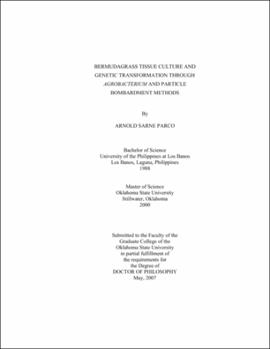| dc.contributor.advisor | Taliaferro, Charles M. | |
| dc.contributor.author | Parco, Arnold Sarne | |
| dc.date.accessioned | 2013-12-10T18:04:36Z | |
| dc.date.available | 2013-12-10T18:04:36Z | |
| dc.date.issued | 2007-05 | |
| dc.identifier.uri | https://hdl.handle.net/11244/7740 | |
| dc.description.abstract | Scope and Method of Study: The primary objective of this dissertation was to develop and optimize methods for bermudagrass tissue culture and genetic transformation. Callus production and subsequent plant regeneration using different explant tissues of selected bermudagrass cultivars were evaluated on solid MS nutrient medium and the promotive effects of plant growth regulator (PGR) supplements were studied. Gene transfer methods utilizing Agrobacterium and particle bombardment were respectively applied to bermudagrass cultivars Guymon and Yukon. | |
| dc.description.abstract | Findings and Conclusions: Caryopsis, young inflorescence, and nodal explants were capable of callus production under 2,4-D supplementations, although no plants were regenerated from nodal segments. Callus induction and plant regeneration frequencies varied with explant type, cultivar, and PGR treatment. The auxin 2,4-D was essential for callus formation but not kinetin and ABA. However, low levels (1-3 mg L-1) of kinetin and/or ABA were found to enhance somatic embryogenesis in caryopsis cultures. Culture of mature caryopses was further developed for utilization in genetic transformation experiments. Evaluation of the toxic effect of hygromycin B on seed germination and growth of seedlings and callus-derived shoots of Guymon and Yukon, indicated that this antibiotic can effectively eliminate untransformed plant materials within 2-3 weeks of selection at concentrations around 50 mg L-1. Seven hygromycin-resistant plants were directly regenerated from stolon nodes of Guymon co-cultivated with Agrobacterium EHA105 harboring pCAMBIA1305.2:UbiSbPHYC plasmid, while twenty-seven hygromycin-resistant plants were obtained from caryopsis-derived embryogenic callus tissues of Yukon bombarded with the plasmid. Transgene integration was verified by PCR amplification of the selectable marker hptII gene and by Southern hybridization of total plant genomic DNA with the hptII probe. Further optimizations of the Agrobacterium method were suggested. This study has yielded transgenic bermudagrass plants that will be screened for constitutive expression of the Sorghum PHYC gene and used in photomorphogenic studies. | |
| dc.format | application/pdf | |
| dc.language | en_US | |
| dc.rights | Copyright is held by the author who has granted the Oklahoma State University Library the non-exclusive right to share this material in its institutional repository. Contact Digital Library Services at lib-dls@okstate.edu or 405-744-9161 for the permission policy on the use, reproduction or distribution of this material. | |
| dc.title | Bermudagrass tissue culture and genetic transformation through Agrobacterium and particle bombardment methods | |
| dc.contributor.committeeMember | Anderson, Michael P. | |
| dc.contributor.committeeMember | Martin, Bjorn C. | |
| dc.contributor.committeeMember | Guenzi, Arron C. | |
| dc.contributor.committeeMember | Melcher, Ulrich K. | |
| osu.filename | Parco_okstate_0664D_2316.pdf | |
| osu.accesstype | Open Access | |
| dc.type.genre | Dissertation | |
| dc.type.material | Text | |
| thesis.degree.discipline | Plant Science | |
| thesis.degree.grantor | Oklahoma State University | |
